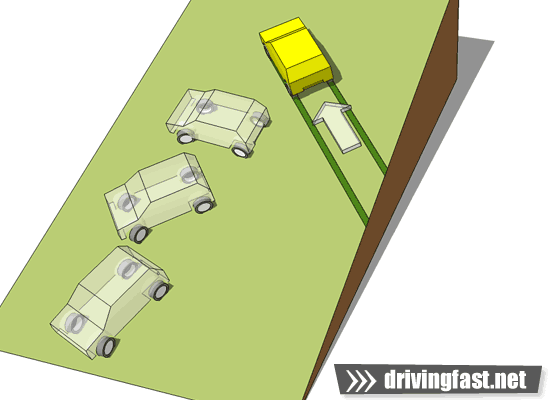Controlling slides off-road
If you’re driving on slippery terrain, you can expect to slide from time to time. Controlling a slide is an important skill to master to ensure safety when off the beaten track. There are several types of slide you can expect to encounter:
- Driving uphill
- Driving downhill
- Driving on a side slope
- Driving on the flat
Rules of thumb
- Don’t panic (easy to say)
- Don’t hit the brakes or clutch
- Use the techniques below to recover
Driving uphill
When attacking a slippery or steep slope, there a chance that although the wheels are turning forwards the vehicle will start to slip back. This can be expected from time to time and grip is usually re-established quickly, but if the car continues to slide backwards you’ll need to take action.
- Press the brake and clutch* together – this will lock the wheels temporarily which will allow reverse gear to be selected.
- Select reverse
- Release the clutch (in amanual transmission vehicle) and brake
- Allow engine braking to take you to the bottom of the slope for a second attempt
- Keep the vehicle straight to avoid side slopes
Driving downhill
Controlling a forwards slide when pointing downhill can be difficult to do. Everyone’s first instinct is to hit the brakes, however this rarely helps the situation as this makes the wheels more likely to lock (which will prevent you from being able to steer). If you are driving down a slope using engine braking and the wheels lose grip it’s usually safest to try and steer round obstacles and come to a halt where possible. Sometimes a dab on the throttle can aid steering and help re-establish traction, but this should only be attempted when there is sufficient room.
Driving on a side slope
If you have no choice but to drive on a side angle, drive as slowly as possible using a light throttle and a low gear to keep the speed down. Sometimes a slide is unavoidable and there will be a temporary loss of control. To recover from this situation, you need to heavy end first to allow gravity to help, rather than hinder:
- Do not hit the brakes or press the clutch – this may be your first instinct but will only lock the wheels or disengage the drive
- Steer down the slope to attempt to get the heavier front of the car pointing down slope
- If the front refuses to come round, try using some gentle throttle to assist the turn
- One the car is pointing downhill, ensure you are off the gas and brakes, allow engine braking to slow the descent
The correct technique to control a sideways slide
Driving on the flat
If you find yourself in a slide on the flat, chances are you’re coving ground at a relatively high speed or traveling in low traction conditions. The two slide situations which can result are know as understeer or oversteer which are explained in detail below with a road bias, but the principles are equally relevant off the road.

Hello! Thank you for these instructional articles.
I have a question on the topic of failing a Hill climb or slipping backwards. I am in an area that has a lot of rocky, steep hill climbs. So steep that there is a risk of tipping over backwards if you apply the brakes too suddenly.
I drive a manual transmission truck and I was wondering if your instructions would change when there’s a risk of tipping backwards.
My thinking, and correct me if I’m wrong, is that it might be better to apply the brakes and not the clutch, letting the vehicle stall, but not roll backwards at all. Rolling backwards and then braking would be even worse. After that, I’d calmly shift into reverse, and actually bump the ignition as I begin to let off the brakes. That way I start in gear and avoid that jolt that you can get when you engage the clutch going down a hill.
Maybe I’m crazy, but I want to know your suggestion.